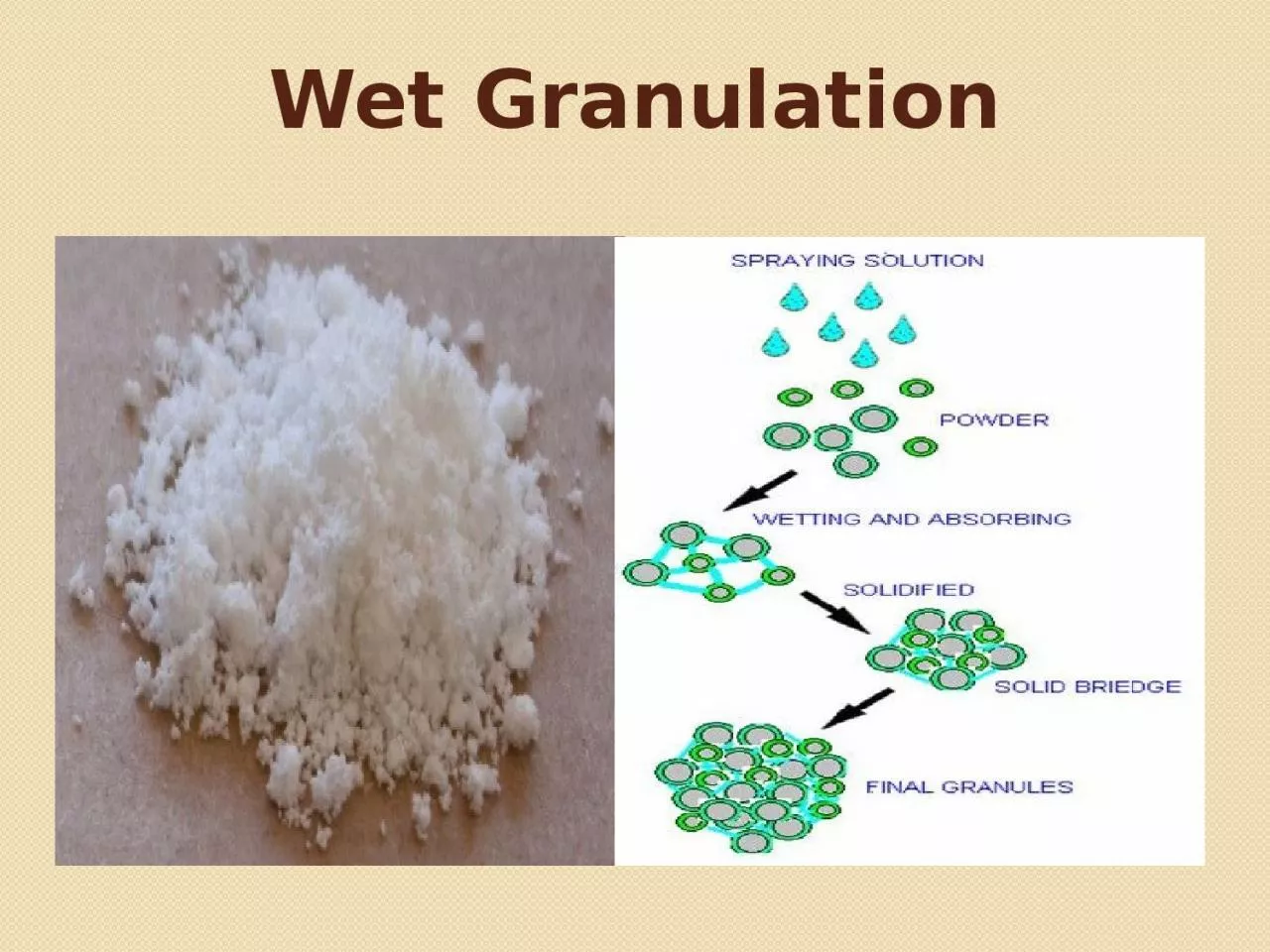

The wet granulation technique uses the same preparatory and finishing steps of direct compression and dry granulation dry screening and mixing it also involve additional steps of wet massing wet screening and drying ID: 926977
Download Presentation The PPT/PDF document "Wet Granulation Wet Granulation" is the property of its rightful owner. Permission is granted to download and print the materials on this web site for personal, non-commercial use only, and to display it on your personal computer provided you do not modify the materials and that you retain all copyright notices contained in the materials. By downloading content from our website, you accept the terms of this agreement.
Slide1
Wet Granulation
Slide2Wet Granulation
The wet granulation technique uses the same preparatory and finishing steps of direct compression and dry granulation (
dry
screening and mixing
); it also involve additional steps of
wet massing, wet screening and drying.
Slide3Steps of Wet Granulation
Slide4Mixing
Wet Massing
Wet
Screening
Drying
Dry Screening
Mixing
Slide51- Mixing
Mixing starts with adding drug then excipients. The mixing process depends on the properties of the drug and excipients. If the drug is soluble in water and excipients are little; so we start to add binder solution to the drug to be distributed uniformly then excipients that have little solubility in water
(e.g. starch)
, it is possible to be added extragranularly [as a whole] or [divided and added as one half intragranulary and the other extragranulary to avoid getting friable tablets].
Total
amount of
disintegrant
is not always
added completely to the powder–diluent mixture (intragranulary), some other portion might be added with lubricants (extragranulary) in the final step prior to compression (double disintegration)
Slide62- Wet Massing
Adhesive (binder) is most commonly employed as
solution, suspension, slurry
, or used as a dry
powder.
Method of introducing the binder
depends on
its solubility
and on the components of the mixture (wettability). In the wet massing step the binder solution will distribute and filling the spaces between particles.
The primary force of granulation act as a bridge and is obtained from surface tension and capillary force or pressure of the liquid (binder solution) between particles.
Slide7Once
the liquid is added, mixing is
continued until
we get a uniform
dispersion
of
the adhesive
within the whole
system.The length off wetting time depends on the wetting property of the powder mix. and the granulating fluid, and on the efficiency of the mixer.The end point
can be determined by the press mass test (ball test) as the mass must be moisten rather than pasty or wet, it is done by pressing a portion of the mass in the palm if the ball crumbles under a moderate pressure, the mixture is ready for the next step (wet screening).
Slide8Note:
If
the material to be granulated is
water sensitive
a great care should be considered by
the use
of
organic solvents (
e.g PVP in isopropyl alcohol as a binder) because it is flammable, expensive, not easily handled.
Over wetting causes:
Slide93-
Wet Screening (granulation)Granulation is performed to obtain a discrete granules and further consolidate the granules by increasing the particles contact points,
and also to
increase surface area to facilitate the drying process.
4- Drying
After
drying
step the granules
should contain some degree of humidity to act as a binder (not be 100% free of humidity) as over drying may leads to weak force and friable granules.
Slide10The
final cohesive force obtained after drying stage when evaporation of solvent occur
as a result of
fusion,
recrystalization
and curing of the binding agent with Van der Waals forces
playing a
significant role.
Slide115- Dry screening
After drying; then dry screening is performed
to get a
homogenized
granules with uniform size and shape
.
6- Mixing
By addition of
lubricants and glidants.Therefore, the granules will posses good compressibility (good cohesive forces once applying punch forming solid impact tab
.), good flowability (spherical shape that is the ideal physical form in providing smoothness and size uniformity to the particles which is easily flow).
Slide12Advantages of wet granulation method:
Slide13Slide14Disadvantages of wet granulation method
Slide15Organoleptic properties:
White
crystalline or white yellowish
fine crystals
or
powder
form,
tasteless or slightly bitter taste. Solubility: Practically insoluble in water, chloroform, and ether; very slightly soluble in ethanol; soluble 1 in 300 of acetone; soluble in dilute mineral acids and in solutions of alkali hydroxides and carbonates. Absorption: it is weak acid (pKa=6.36), so they are well absorbed from GIT, mainly in stomach because are present in undissociated form.
Preparation of Sulfadiazine (sulfa drug) by wet granulation
Slide16Stability:
Stable in dry air and not affected by moisture and heat
, slowly
darken and
decompose, so
should be
protected
from light should
be kept in dark closed container (opaque containers).Sulfadiazine is prepared by wet granulation method for the following reasons:
Slide17Sulfa drug are not prepared by direct compression
because:
Slide18Example
Sulfadiazine 250 mg (active
ingredient)
Ca
carbonate
250
mg (diluent)
Explotab
50 mg (disintegrant)Zn stearate 10 mg (lubricant)Acacia mucilage 20%(w/v) q.s. (binder) prepare
50 tablets
Slide19Answer
Mix all ingredients except lubricant and binder.Add the binder drop by drop (ball test).C
alculate the weight of acacia in each tablet
(If
we use for example 5 ml of
(20%w/v) acacia mucilage for 50 tab.)
20
gm
100 ml x 5ml = 1 gm of acacia for 50 tab1gm/50 *1000= 20 mg of acacia per
tab.
Slide20Calculate the
theoretical wt. of one tablet (without lubricant) 250
mg+250 mg+50
mg+10
mg =
560
mg wt
. of one
tablet without lubricant Weigh the prepared granules (actual wt. of tablets without lubricant)for example it was found to be 22800 mg Find the real no. of tabletsReal no. of
tab. = actual wt./theoretical wt. =22800 / 570 =40 tablets
Slide21Calculate the actual amount
of lubricant to be added:
amount of lubricant =10
mg
* Real
no.
of tab.
=10 * 40
=400mg of lubricant added
Slide22Question
Na2
CO
3
125mg
Lactose 100mg
Starch
10mg
Acacia mucilage 20%(w/v)q.s.Zn stearate 0.5mgPrepare 20 tablet
Slide23